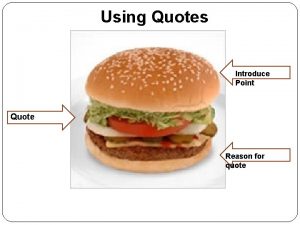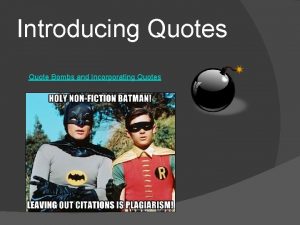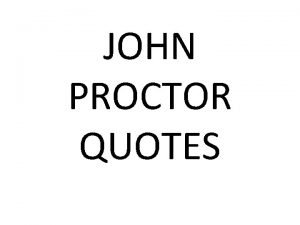Quote Integration How to properly integrate quotes into






- Slides: 6

Quote Integration How to properly integrate quotes into an essay

What NOT to do: Never DROP a quote into your writing – always integrate quotations In other words, a quote should not stand alone as it’s own sentence, you must use your own words to introduce it.

What you SHOULD do: Choose the most important part of the quote. Make sure the quote fits grammatically within your sentence. Use an ellipses as needed to omit unnecessary parts of the quote. Use brackets [ ] to add or change words.

Examples: Drop quote (bad example): Boo Radley scares the children of Maycomb. “Boo was about six-and-ahalf feet tall, judging from his tracks; he dined on raw squirrels and any cats he could catch” (Lee 45). Properly integrated quote (good example): The children of Maycomb fear Boo Radley because he “was about six-and-a-half feet tall…[and] dined on raw squirrels” (Lee 45).

The Quote “Sandwich” Each integrated quote should use the quote sandwich (named because you are “sandwiching” the quote with your own words): Quote intro: provides context, signals quote is coming Quote: choose only important parts of quote that prove your point Commentary: explain how the quote helps prove your topic sentence/thesis In-text citation: give credit to the author

Integration Patterns: • Pattern #1: An introducing clause plus the quotation: Gatsby is not to be regarded as a personal failure because "Gatsby turned out all right at the end”, according to Nick (Fitzgerald 176). • Pattern #2: An assertion of your own and a colon plus the quotation: Fitzgerald gives Nick a muted tribute to the hero: "Gatsby turned out all right at the end" (176). **This works best if your quotation is a complete clause • Pattern #3: An assertion of your own with quoted material worked in: For Nick, who remarks that Gatsby "turned out all right" (176), the hero deserves respect but perhaps does not inspire great admiration. **This works best when you pull only power words from the quotation.











